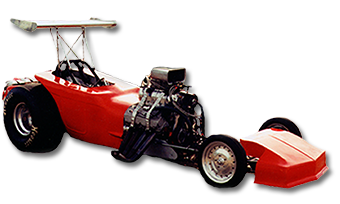For a new setup, a conservative ignition timing value should be the first thing a tuner should dial in. Other setups, including the fuel system and the chassis, should be optimized before the timing is extended beyond a conservative value for more performance. The amount of timing depends on the strength of the ignition. For example, 42 degrees of timing worked well for an old 2 ampere magneto in our blown alcohol bracket Hemi. A lesser value of 36 degrees of timing worked well for a newer, more powerful 3.8 ampere magneto. Engine power for both ignition systems was the same when air/fuel ratio was maintained to an optimum value.
Three types of ignition timing setups are used: locked advance, mechanical advance with engine speed, and programmable advance. For a locked advance with an electronic ignition on a small block, 35 to 38 degrees is a common. More advance is normal for a richer air/fuel ratio. For a locked advance with a 44 ampere magneto on a 2,000+ HP blown alcohol V-8, timing is dependent on the air/fuel ratio as well. Timing of 22 degrees is common for moderate air/fuel ratios typically around 3.8 to 1 for big block semi hemi or wedge heads. For overly rich mixtures such as 3.1 to 1, timing of 28 degrees is common.
Timing advance with a linear increase with engine speed is done with a centrifugal advance distributor or programmable ignition control module. A recommended advance is 1 to 1.5 degrees of added timing per 1,000 RPM increase. That would be less timing at low RPM and more timing at high RPM. For example, a centrifugal or programmable advance would be set up for 20 degrees of timing for idle speed and 35 degrees of timing for a high RPM shift point and/or at the finish line.
Some setups use programmable timing for different functions. One example is a momentary drop in timing on the launch to reduce engine power for consistency such as in bracket racing with a high torque launch setup. A drop of 10 degrees of timing can reduce launch torque typically 200 foot pounds and keep the tire from shaking or spinning at launch on a bad track. Tuning involves adjustment of the amount of drop or the duration before full timing is brought back in.
Another example is a drop in timing in high gear to reduce engine temperature. High gear timing reductions are often a ‘guestimate’ to compensate for temperature buildup in high gear. An often-overlooked cause for the increase in temperature is from lean-out in high gear, high speed. This is due to ram air into a forward facing air scoop. Instead, enrichment to restore the air/fuel ratio is often a better alternative. For example, approximately 200 MPH can produce an air pressure increase of 4 inches of mercury from ram air in a forward facing air scoop. A typical high powered engine will consume half of that air or 2 inches of mercury pressure. The remaining 2 inches of mercury pressure will lean out the high end air/fuel ratio about 0.4 air/fuel ratio points. That can be too lean, causing engine heat build-up.
This lean condition can be very well compensated with a high-end fuel increase instead of timing drop. For fuel injection, that can be done with added nozzles on the supply side, or a normally open bypass poppet on the return side that closes with pressure. An example is the Engler Machine & Tool stumble valve that is used in circle track racing to reduce engine cooling under yellow flag idling. Enabling either can be done with pressure from high RPM, a timer controlled solenoid, or driver controlled cable. Ignition timing changes in high gear may be avoided, and top end power is usually increased. In fact, the engine temperature of most drag racing engines can be modulated very well with a proper high end air/fuel ratio from appropriate enrichment with higher speed when ignition timing is not reduced.
